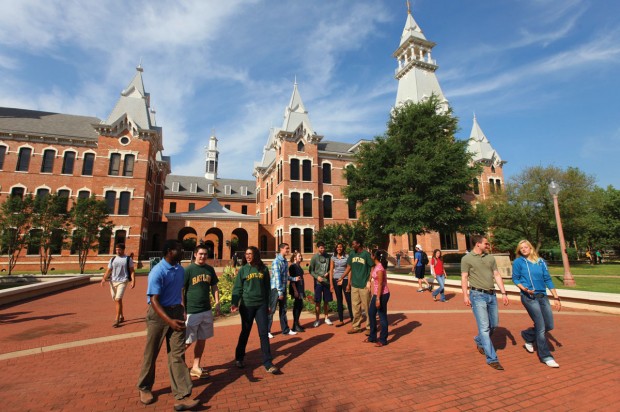Applying to College
How to survive the process


“Don’t tell us what you think we want to hear” and “Be yourself” are two pieces of advice The University of Texas at Austin gives about college-application essays. (Photo: The University of Texas at Austin)
I confess: When my son was 18 months old, I sent him to a nursery school that required an interview – with him – as part of the admissions process. Word on the parents’ benches at the playground was that the school was a “Baby Ivy” (we were in Manhattan), a “feeder school” for good elementary schools, which in turn would feed into good middle and high schools, which ultimately would land him in a good college.
Do we parents, and in turn, our children, really need to worry like this?
I interviewed admissions officers from a selection of Texas universities, and while they didn’t give me the answer I was hoping for (“Don’t worry. It’s easy to get into Harvard”), they did put things into perspective.
If you’re thinking, “What’s the big deal? I did my college applications myself, with little input from my parents,” then you need to know that applying to college has changed. For a variety of reasons, not least that college is more expensive than it used to be, parents feel the need to be more involved.
And college admissions can seem more competitive. The number of high-school students in the United States has only recently begun to level off from an all-time high, with some regions, including Texas, still experiencing growth. A bigger percentage of these kids are applying to four-year colleges, and, thanks in part to online universal applications, each applicant, on average, applies to more schools. According to the Higher Education Research Institute at UCLA Los Angeles, the number of college applications per student has doubled over the last 40 years, with 24 percent of current students applying to eight or more each.
Many schools, such as Baylor University, are receiving record numbers of applications. As a result, some schools are reporting their lowest “admit rates” ever. Stanford University was in the news recently for having the lowest admit rate, 5.7 percent, for the fall of 2013. According to U.S. News & World Report, Harvard followed closely, with 5.8 percent, and Columbia came in at 6.9 percent.
Our own Rice University admits only 15 percent of its applicants, according to Chris Muñoz, Rice’s vice president of enrollment. This puts Rice in line with Swarthmore College, Bowdoin College and Cornell University. Muñoz described the quality of Rice’s applicant pool as “astonishing” and pointed out that even perfect GPAs and test scores do not guarantee admission to Rice.
But while much of the press coverage – and cocktail-party chatter – we hear focus on these most selective schools, the reality is, according to Jeff Fuller, director of student recruitment for the University of Houston’s Central Campus and the president of the National Association for College Admissions Counseling (NACAC), that only about 100 of the approximately 3,000 four-year institutions in the U.S. fall into the category of “most selective.”
The vast majority of U.S. colleges and universities accept most of their applicants, according to the NACAC. And many are on the hunt for prospects. According to a 2014 survey by Inside Higher Ed, 61 percent of schools had not filled their fall freshman class by May. College-admissions officers say you can get into a good college, though it may not be the one you first hoped for.
This is not to say that students should not apply to selective or well-known schools, but knowledge of schools’ admit rates can help them from taking rejection letters personally. “You could be very, very academically prepared and capable and not get in. It’s a numbers game,” said Brandie Eneks, associate director of admissions and student services for Texas A&M University. One area family refers to their children’s applications to “reach schools” as “the lottery tickets,” to help their children keep a healthy perspective.
“What creates people’s anxieties is that they don’t know what is going to make the difference” in an application, said Rice’s Muñoz. Of course, the standard advice is to note the average GPAs and test scores of successful applicants (available in directories and on school websites) and select some “match” (you fit the parameters), some “safety” (you exceed them) and some “reach” (you are a little below) schools to apply to. But the truth is, much is not within the students’ control. Kids need to know: In a quest to create a diverse, vibrant class, admissions officers may pick another applicant, with credentials similar, or even lesser, just because he is from Wyoming or she plays the oboe.
Above all, kids need to know that where they are accepted or rejected is not a “referendum on their self-worth,” said Stuart Dow, head of The Emery/Weiner School. In fact, at Emery/Weiner, students post, not their acceptance letters, but their denial letters on a school wall. This is meant to emphasize that receiving a rejection, something most kids will experience, is not the end of the world.

In 2013, over 52,000 prospective students – a record number – visited Baylor University in Waco. (Photo: Robert Rogers/Baylor Marketing & Communications)
Parents should talk to their children about all of this, said University of Houston’s Fuller. “Where they get into college is just one small piece of their lives,” he said. One father explained to his children that the credentials they’ve achieved, or haven’t, so far in their lives aren’t going to follow them forever. “Once you get into college, no one is ever going to look at your high-school grades again,” he said.
While students may understandably be excited to work on their dream school’s application first, one mom suggested having them apply as early as possible, but in a non-binding way, to a “safety school.” Receiving that first acceptance letter can ease their stress. “They’ll know, hey, no matter what, they have a place to go,” said this mom, “and they’ll have an answer when everyone asks – and everyone will – if they’ve been accepted anywhere.”
Every admissions officer interviewed stressed that the most important part of the application process is researching what colleges, from all the ones out there, you might be interested in. This also helps turn students’ attitudes around, by having them focus on, not, “How can I get these schools to want me?” but, “Do I want these schools?”
Christine Bowman, dean of admissions and enrollment services at Southwestern University in Georgetown, Texas, recommends going on a few tours of schools near you as early as your child’s sophomore year. This is not to get a competitive advantage but to experience some colleges in a low-stress way, to see what a big school is like versus a small one, for example. And at the information sessions, students will hear the same advice you’ve been giving them – study hard, choose rigorous courses – from someone else. “If they hear ‘the admissions lady at Southwestern’ say it, it might carry more weight,” said Bowman, whose own daughter, attending an information session at another school, turned to her and conceded, “Okay, you win.”
Students should not be afraid to contact schools directly. This personal contact can alleviate some stress and clear up questions. “We’re here to serve you and want the student to submit the best application possible,” said A&M’s Eneks. According to Fuller, at least 20 out-of-town and some out-of-state schools keep permanent admissions offices in Houston to encourage contact. “School representatives are one of your best resources,” said Alex Mitchell, director of the Houston Admissions Center for The University of Texas at Austin.
Demonstrating knowledge of the school can make your application shine. One of Rice’s essays asks the applicant, basically, “Why Rice?” “If you can replace the word ‘Rice’ in that essay with ‘Cornell’ and the essay still works, it’s not a good essay,” said Muñoz.
The admissions processes at schools do vary a bit. UT and A&M, for example, have automatic admissions if you meet certain criteria, such as class rank. Some big schools, because they receive tens of thousands of applications, cannot offer the opportunity to interview and may ask for short-answer questions rather than full-blown essays. However, the information requested – transcripts, test scores, essays or short-answers, activities – is basically the same. And the applicant should make each piece of information as good as it can be.
This means, yes, working to get good grades and taking the most rigorous high-school courses that make sense for you as well as preparing for and taking the SAT and/or ACT as many times as possible. Essays should be polished – though students should write them themselves. “When an essay sounds very contrived, we can almost guess which consultant they hired,” said Rice’s Muñoz. And if something is optional, like an interview or teacher recommendations, it’s best to turn it in. (It’s like when your mom asks, rather than tells, you to take out the garbage.)
Admissions officers like to see an applicant’s activities and report that, sometimes, students don’t list all of them. “A college application, like a job interview, is one of the few times it’s okay to brag about yourself,” said University of Houston’s Fuller. Your application, said A&M’s Eneks, “is your opportunity to shine. If you don’t tell us, no one else will.”
While parents and students might speculate on which activity or sport seems “more impressive” to colleges, admissions officers look for how committed a student is, sometimes in terms of hours spent (asked on both the Common App and Apply Texas), to whatever the interests are. “Whether they are involved in one thing heavily or several things, but each less heavily, doesn’t matter,” said Brian Kim, admissions counselor for the Houston area for Baylor University. “They should do whatever they are most passionate about and truly love doing.”
Southwestern’s Bowman cautions that, “Sometimes the arms race of perfection creates more stress and tension than there needs to be.”
Like, for instance, when my son clung to my leg during his nursery-school interview, letting go only to slug another boy. And he still got in.
Helpful college links
Colleges That Change Lives, Inc., a nonprofit organization founded by the schools, including Southwestern University, featured in the book of the same name, has helpful information including these tips on beginning your research into colleges.
Many colleges and universities provide information about that application process that are helpful in general, such as these tips from UT or this page’s video, on putting together a portfolio of art, from Ringling College of Art + Design in Sarasota, Florida.
The College Board has information on its website about the new SAT and also offers a college-research tool called Big Future.
This Huffington Post article talks more in depth about college admissions reps.
A recent op-ed piece about college admit rates from The New York Times.
You can find a partial list of schools with Houston offices on the website for the Houston Area Recruiter’s Network.
Or you can find information about Houston offices and reps on the universities’ websites, such as these pages for UT Austin, Texas A&M University and Austin College in Sherman, Texas.
Find out about upcoming college fairs from the National Association for College Admission Counseling college-fair webpage.
Want more buzz like this? Sign up for our Morning Buzz emails.
To leave a comment, please log in or create an account with The Buzz Magazines, Disqus, Facebook, or Twitter. Or you may post as a guest.


